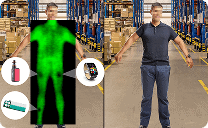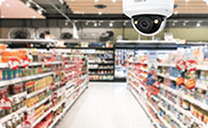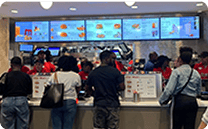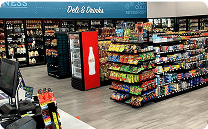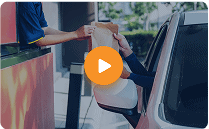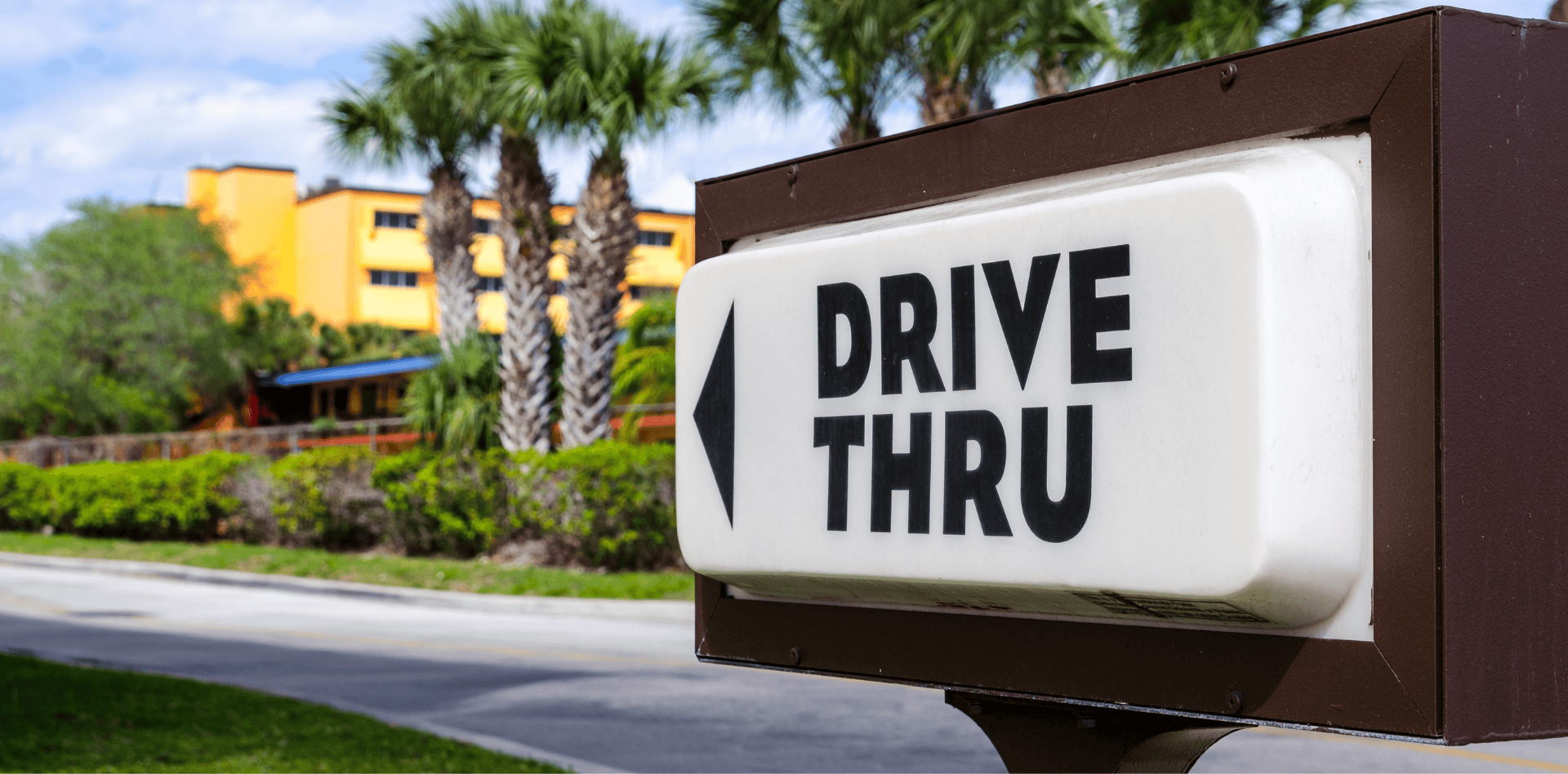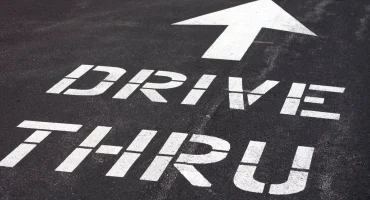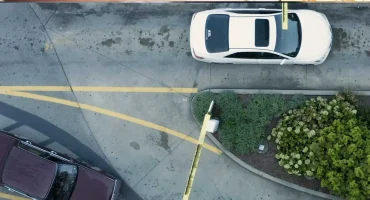In This article
Drive-thrus have come a long way since the days of just being a single lane. And it’s no wonder there are so many new types of drive-thrus. With roughly 70% of business coming through the drive-thru, it’s arguably the most important feature of your QSR to ensure success.
To help you achieve drive-thru success, this article will go over:
- The different types of drive-thrus
- How to determine which drive-thru style is right for your QSR
- Nine tips to supercharge your drive-thru performance, regardless of style
Let’s go (drive) thru these tips.
Single Lane Drive-Thru
The single-lane drive-thru is one of the most traditional types of drive-thrus that many older QSRs use currently. This model typically has one lineup for customers to drive-thru. They stop at a singular order point, place their order, and then proceed to a singular window (potentially two windows if your operation has a window for payment and another window for receiving the food). Everybody follows one path, meaning one car gets through at a time.
Y-Lane Drive-Thru
Y-Lane drive-thrus are another one of the types of drive-thrus that QSR owners can explore. This is where you have two lanes with two separate order points. Cars can enter at whichever lane they choose, and then the two lanes merge into one. Diners wait in a single line to receive their food and pay.

Pro tip: It can get confusing for your staff when the drive-thrus merge in a different order than the food orders are placed in. This can lead to quite easily mixing up orders and your guests receiving the wrong food. DTiQ’s Drive-Thru Order Accuracy Solution uses smart video to pair images of cars with an overlay of their order. The cars and their orders are displayed in tandem on a screen for your team, making it easy to ensure everybody gets what they ordered.
Dual Lane Drive–Thru
Take the single lane drive-thru and double it, and you have your dual lane drive-thru! This set up has two of everything. Two lanes for people to enter, two order points, two different paths to follow after ordering, and two pick up windows. This model works well for stores that have drive-thru windows on both sides of their building.an outline of a dual lane drive-thru, one of the types of drive-thrus

Tandem Drive–Thru

Your tandem drive-thru follows the flow set by a single lane drive-thru but allows double the cars to get through the same amount of space. A tandem drive-thru allows two drive-thrus to operate at once on the same path. There are two order points, two order takers, and two pickup windows.
How to Determine Which Drive-Thru Makes Sense for Your Business
Are you debating if it’s time to upgrade your single lane drive-thru? Trying to decide what style of drive-thru is right to install at a new location? Here are some factors to help you consider which type of drive-thru is right for your space.
Space
Typically, more lanes and windows = more space required to implement it. If you’re tight on space, creating a tandem drive-thru may be trickier compared to a y-lane drive-thru that merges together.
Staffing
You may have the space to create a fifteen-lane drive-thru with that many windows, but do you have the people to run it? Consider what you’ll realistically be able to scale your staff to. It’s a recipe for disaster if you have double the drive-thru windows but not double the staff to get orders out.
Cost
You will face a larger upfront cost with a larger or more intricate drive-thru set up. Your dual lane drive-thru will require essentially double all the assets — double ordering points, double drive-thru windows, and double the equipment at each drive-thru window. Setting a realistic budget for your drive-thru install will help in the decision of what type of drive-thru is right for your QSR.
It is important to note, however, that scaling your drive-thru is an investment — an investment that will very, very likely pay off. As more QSR business funnels to the drive thru (vs. Coming indoors), you want — no, need — to be able to meet the demand if you hope for your franchise to be successful.
How to Optimize Different Types of Drive-Thru Performance
You’re always going to want to improve your drive-thru performance.
So how do you optimize? Here are nine tips that will help, no matter the types of drive-thrus you’re working with.
1. Streamline your ordering process
The first step to optimizing your drive-thru performance is to streamline your ordering process. Train your team to use clear and concise language when taking orders and have a standard order taking script to ensure that nothing is missed. Implement an electronic ordering system to make order taking easier and faster.
2. Use the right technology
Naturally, you use some technology for your drive-thru. But is it the right technology?
Technology is evolving all around us, and drive-thru technology is no exception. There are timers that gamify performance, headsets that you can listen to interactions at the window, and smart video that matches the transaction to each car on a video, making it near impossible to get the order wrong. All this technology makes for a smoother experience at the drive-thru, both for customers and staff.
By working with outdated tech, you risk just clogging up your operations.
3. Plan for third-party delivery and pre-ordering as part of the drive-thru
They say that if you fail to plan, you plan to fail. And if you fail to plan for third party and pre-orders as part of your QSR drive-thru operation, you’re planning to fail.
The integration of your third-party delivery apps or pre-order apps is going to impact your drive-thru operation. The popularity of ordering ahead and driving through to pick up is growing.
4. Organize your menu boards
Organizing your menu boards can help customers make their orders quickly and efficiently. Place the most popular items at the top of the menu board and group similar items together. Use large, clear fonts that are easy to read, and avoid using too many colors or graphics that may distract customers.
5. Work with a drive-thru timer
Using a timer system can help you track how long it takes to serve each customer and can help you identify areas where you can improve your performance. You can set a goal for how long it should take to serve each customer and use the timer system to track your progress — think about rewarding your team for a time that goes down.
This technology has evolved to the point that timers do more than time. You can turn drive-thru timers into a game for your store or competition against other stores that are a part of your franchise group. A little friendly competition can go a long way.
6. Give each team member a specific job
Assigning specific roles to your team members can help you optimize your drive-thru performance. Have one team member take orders, another team member prepare the food, and another team member hand out the orders. This will help you ensure that each task is being done efficiently and quickly.
7. Provide adequate training
Giving people a role and moving on isn’t enough. Once you or your management team have assigned specific roles, it’s imperative that you train your team to thrive in these roles. Adequate training for your team members ensures that they are proficient in their assigned roles. This will help reduce errors and ensure that each task is being done correctly. Regularly evaluate your team’s performance and provide feedback to help them improve.
One thing you should do is rotate assigned roles between the staff so that your team gains experience across each of them. This allows them to level up their skills while ensuring that you have a capable team of individuals who can step in if somebody calls out sick, without compromising the experience for your customers.
8. Keep your equipment and supplies organized
Organization is a critical part of a smooth drive-thru operation. Make sure that everything is easily accessible, your team is trained on where to find everything, and ensure you have backup supplies easily available in case something runs out.
9. Keep a positive attitude
Positivity is key, especially when facing customers. Train your team to greet each customer with a smile and thank customers for their business. When your customers feel valued, even during a brief drive-thru experience, they will want to come back.
This is especially important when it comes to delivering bad news at the drive-thru. Chances are, you have been on the receiving end of bad news while in line at the drive-thru — the ice cream machine is broken, they are out of the nuggets, or something else. Training your team to deliver that news to customers politely is what will ensure that, despite a less than positive experience, they’ll still feel positive about coming back.
Final Thoughts on Types of Drive-Thurs and Drive-Thru Optimization
With so many different types of drive-thrus, it can feel daunting before you even install one. You must make a choice of which type of drive-thru is right for your business and then make sure it runs smoothly.
Optimizing your drive-thru performance at a quick service restaurant requires a combination of efficient processes, clear communication, and effective team management. By implementing these tips, you can help ensure that customers are served quickly and efficiently with any type of drive-thru, which can help improve customer satisfaction and drive sales.
If you want to elevate your drive-thru technology (for ANY type of drive-thru), see how DTiQ and Summit Innovations can help. You can contact us or book a demo to see our technology in action — and how we can work together to optimize your drive-thru performance.
